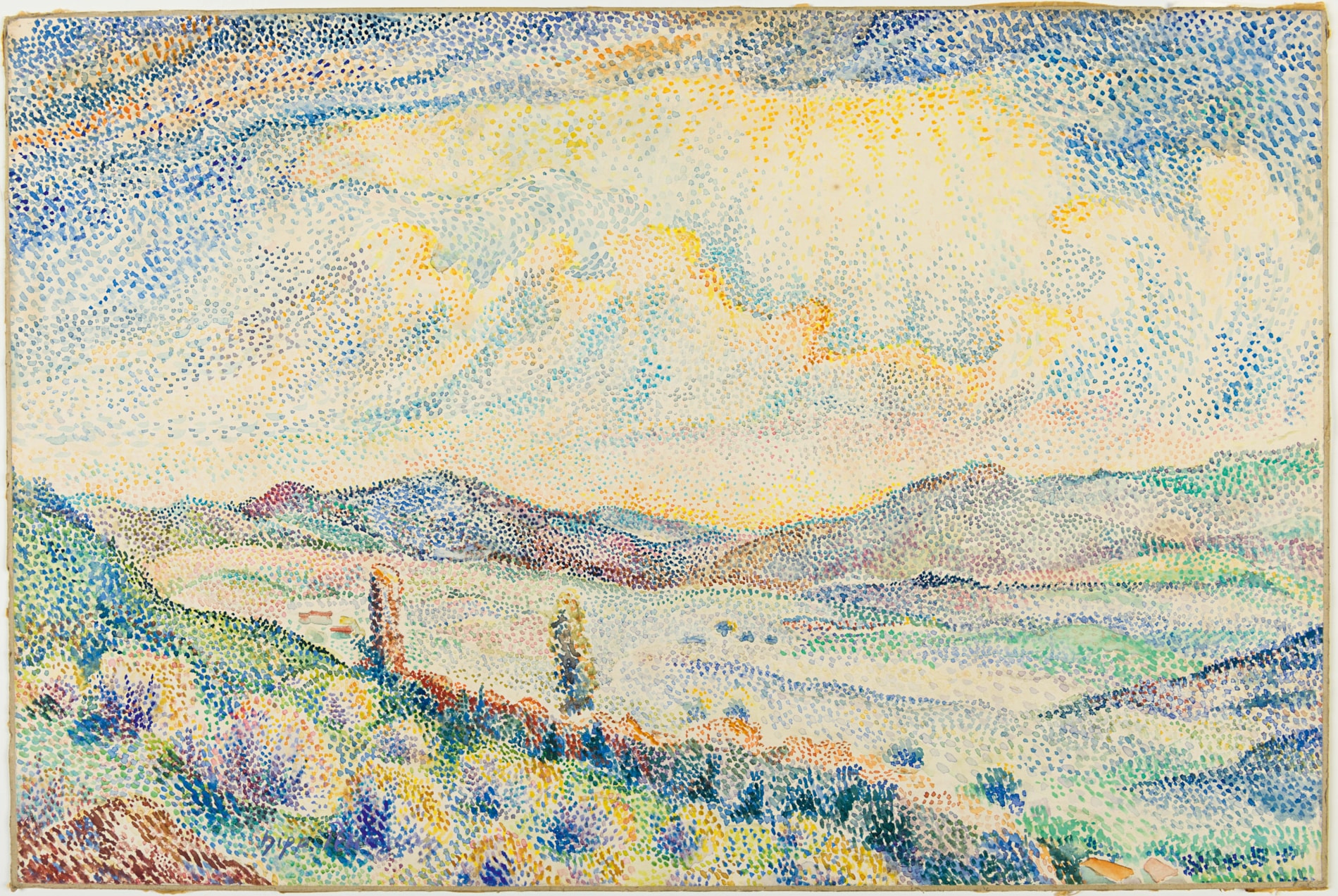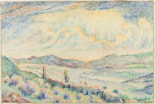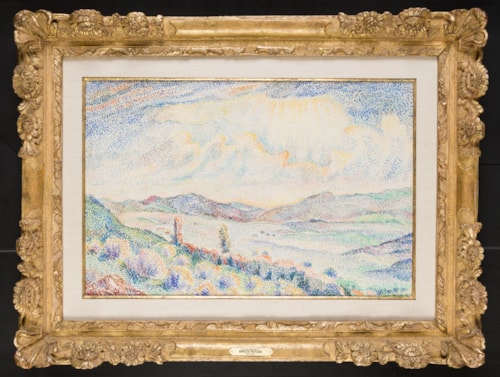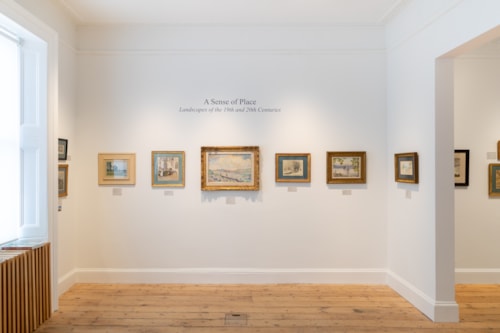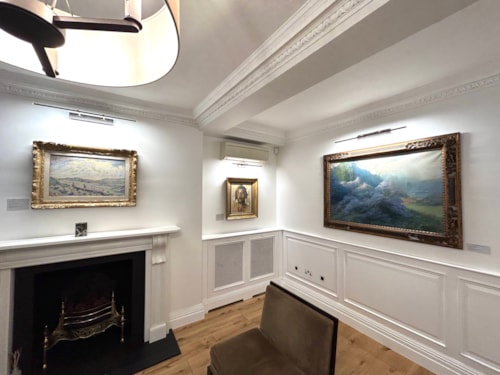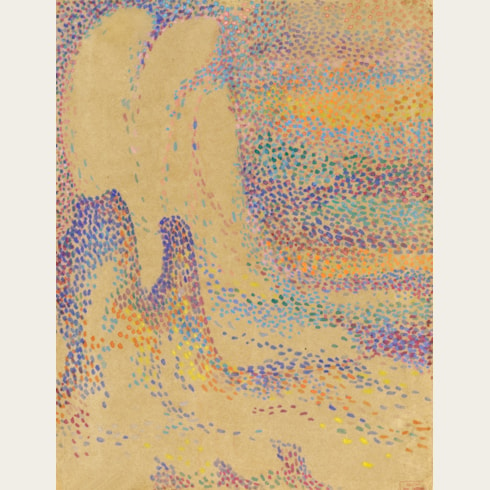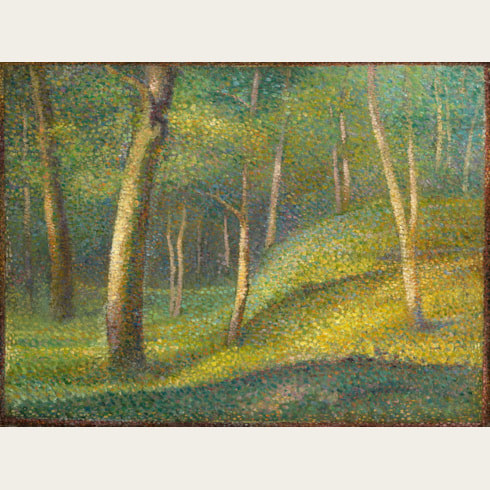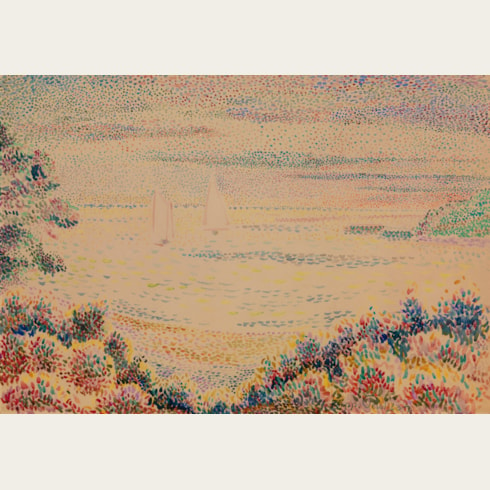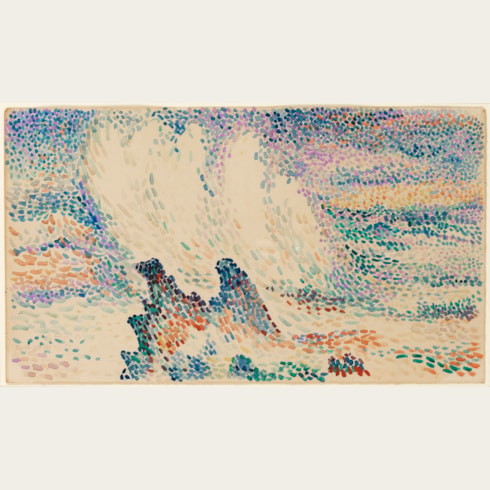Hippolyte PETITJEAN
(Mâcon 1854 - Paris 1929)
Mountainous Landscape
Watercolour on paper, laid down on board.
Signed hipp Petitjean in violet ink at the lower left.
388 x 587 mm. (15 1/4 x 23 1/8 in.)
Signed hipp Petitjean in violet ink at the lower left.
388 x 587 mm. (15 1/4 x 23 1/8 in.)
Arguably Hippolyte Petitjean’s most distinctive and original contribution as a Neo-Impressionist artist are his vibrant pointillist watercolours, of which the present sheet is a particularly fine example. Approximately two hundred watercolours by the artist are known, many of which were made as independent works of art to be sold to collectors. As one modern scholar has noted, ‘As with most of [Petitjean’s] works, his watercolors are not dated, nor are their locations identified. In executing them, he employed the divided color technique very freely, applying dabs of color in a loose network that allows the white of the paper to show through...in his pure landscapes the artist takes a more individual approach, subtly modulating the different areas of color to suggest gradual spatial recession or the light effects of a setting sun.’ From around 1912 onwards, Petitjean’s watercolours are characterized by more widely spaced dots of pure colour, in which the surface of the paper shows through.
In a letter dated 1 September 1893, Petitjean wrote to Camille Pissarro: ‘I worked more than usual, but nothing important, pochades, sketches, watercolours, a genre in which I am not very skilled but which I find very good for taking quick colour notes and which interests me a lot. In front of nature, it seems to me that instinctively I feel more and more the need to grasp the side of decorative simplicity but still a lot of indecision. I am also required by the diversity of tones and here is the difficulty: variety in unity. This is what I find is good in watercolour which, by its manner, forces you to a synthetic interpretation...’
The range and variety of Hippolyte Petitjean’s watercolours were only rediscovered several years after his death, at a centenary exhibition of his work at the Galerie de l’Institut in Paris in 1955. As one modern scholar has noted of these Neo-Impressionist watercolours, ‘All executed in pointillist style, they reveal a very individual side of his talent which fully justifies the collectors’ interest in them.’
Almost certainly intended as a finished work of art for sale, this very large sheet is a fine example of Petitjean’s mature pointillist technique as a watercolourist. Among stylistically comparable and sizeable watercolours by the artist is a view of A Broad Valley at Sunset in the National Gallery of Art in Washington, D.C. and The Seine at Mantes-la-Jolie in the Indianapolis Museum of Art, as well as A Boat on a Pond in the Carmen Thyssen-Bornemisza Collection at the Museo Nacional Thyssen-Bornemisza in Madrid. Another closely comparable pointillist watercolour of sailboats in a bay by Petitjean, of similar dimensions to the present sheet and signed in the same way, is in the collection of the National Gallery of Canada in Ottawa.
In a letter dated 1 September 1893, Petitjean wrote to Camille Pissarro: ‘I worked more than usual, but nothing important, pochades, sketches, watercolours, a genre in which I am not very skilled but which I find very good for taking quick colour notes and which interests me a lot. In front of nature, it seems to me that instinctively I feel more and more the need to grasp the side of decorative simplicity but still a lot of indecision. I am also required by the diversity of tones and here is the difficulty: variety in unity. This is what I find is good in watercolour which, by its manner, forces you to a synthetic interpretation...’
The range and variety of Hippolyte Petitjean’s watercolours were only rediscovered several years after his death, at a centenary exhibition of his work at the Galerie de l’Institut in Paris in 1955. As one modern scholar has noted of these Neo-Impressionist watercolours, ‘All executed in pointillist style, they reveal a very individual side of his talent which fully justifies the collectors’ interest in them.’
Almost certainly intended as a finished work of art for sale, this very large sheet is a fine example of Petitjean’s mature pointillist technique as a watercolourist. Among stylistically comparable and sizeable watercolours by the artist is a view of A Broad Valley at Sunset in the National Gallery of Art in Washington, D.C. and The Seine at Mantes-la-Jolie in the Indianapolis Museum of Art, as well as A Boat on a Pond in the Carmen Thyssen-Bornemisza Collection at the Museo Nacional Thyssen-Bornemisza in Madrid. Another closely comparable pointillist watercolour of sailboats in a bay by Petitjean, of similar dimensions to the present sheet and signed in the same way, is in the collection of the National Gallery of Canada in Ottawa.
Hippolyte Petitjean left school at thirteen and began his training as a draughtsman in his native Mâcon while working as an apprentice housepainter. In 1872 he won a grant to study in Paris, where he continued his training at the Ecole des Beaux-Arts, in the studio of the academic painter Alexandre Cabanel. In 1886 he joined the group of artists known collectively as the Neo-Impressionists, led by Paul Signac and Georges Seurat. (The term ‘Neo-Impressionism’ had been coined by the art critic Félix Fénéon in a review of the last Impressionist exhibition in 1886, in which divisionist paintings by Seurat, Signac and Camille Pissarro were hung together in one room.) Petitjean enjoyed a close friendship with Seurat, whose influence is particularly noticeable in the younger artist’s dark conté crayon drawings of this period. In his mature work, he continued to remain true to the pointillist techniques of Seurat, although his compositions were also influenced by the work of the Symbolist painter Pierre Puvis de Chavannes. Petitjean exhibited at the Salon des Artistes Indépendants in Paris from 1891 onwards, and the following year took part in a number of small gallery exhibitions devoted to the Neo-Impressionist artists. He also contributed to exhibitions in Belgium (where he showed with the avant-garde group of artists Les XX in 1893 and its successor Le Libre Esthétique in 1898), Sweden and Germany.
Unlike many of his colleagues, Petitjean struggled financially for most of his career, and lived in relative poverty, only earning a modest salary as an art teacher. It was not until the sale of some of his paintings at a group exhibition of Neo-Impressionist artists at the Galerie Durand-Ruel in 1899 that he achieved a small measure of financial stability, but later years still found sales few and far between. In a notebook in which the artist carefully recorded his output between 1886 and his death, numerous paintings, drawings and watercolours are listed as having been being gifted or sold to creditors in exchange for services, or to pay bills, while in several years no sales are recorded at all. After 1917 Petitjean’s output slowed considerably, although his work continued to be exhibited with the Neo-Impressionists.
Petitjean maintained an adherence to Neo-Impressionist principles throughout his career, even after the decline in the movement’s critical fortunes following Seurat’s death in 1891. Not long after this, some members of the group, notably Camille Pissarro and his son Lucien, started to become disillusioned with the rigid demands of the pointillist technique. Yet despite Pissarro’s comments in a letter to Lucien written in January 1894 (‘I will give you the details of what passed between Petitjean and Signac; this is only the beginning of disagreeable discussions among the Neos, for Petitjean completely agrees with our view that there is no future in a method as constricted as that of the dot exclusively!’1), Petitjean seems never to have abandoned pointillism as a method of artistic expression. In his survey of the Société des Artistes Indépendants, published in 1920, the scholar and critic Gustave Coquiot noted that ‘In the phalanx of neo-impressionists, M. Petitjean ranks very high. He is best known for his Bathers, of pure classical style, and for his vividly coloured landscapes.’ The artist continued to exhibit his work regularly at the Salon des Indépendants until the very end of his career. In May 1929, shortly before his death, an exhibition of twenty-eight of his works was mounted at a Parisian gallery, from which one painting was purchased by the State for the Musée du Luxembourg.
Although he lived to the age of seventy-five, Petitjean was never very prolific as a painter, with an oeuvre of around 350 paintings, although some of these were rather large in scale. His subject matter included landscapes, urban scenes, mythological subjects and, occasionally, portraits. These works were often preceded by several preparatory studies, usually made en plein-air, though the paintings themselves were almost always executed in his large Parisian studio, built with the proceeds from the sale of two paintings by his friend Seurat.
In 2015-2016 a major Petitjean retrospective was mounted at the Musées des Mâcon, which today holds a substantial collection of the artist’s work, amounting to some 117 paintings and drawings.
Unlike many of his colleagues, Petitjean struggled financially for most of his career, and lived in relative poverty, only earning a modest salary as an art teacher. It was not until the sale of some of his paintings at a group exhibition of Neo-Impressionist artists at the Galerie Durand-Ruel in 1899 that he achieved a small measure of financial stability, but later years still found sales few and far between. In a notebook in which the artist carefully recorded his output between 1886 and his death, numerous paintings, drawings and watercolours are listed as having been being gifted or sold to creditors in exchange for services, or to pay bills, while in several years no sales are recorded at all. After 1917 Petitjean’s output slowed considerably, although his work continued to be exhibited with the Neo-Impressionists.
Petitjean maintained an adherence to Neo-Impressionist principles throughout his career, even after the decline in the movement’s critical fortunes following Seurat’s death in 1891. Not long after this, some members of the group, notably Camille Pissarro and his son Lucien, started to become disillusioned with the rigid demands of the pointillist technique. Yet despite Pissarro’s comments in a letter to Lucien written in January 1894 (‘I will give you the details of what passed between Petitjean and Signac; this is only the beginning of disagreeable discussions among the Neos, for Petitjean completely agrees with our view that there is no future in a method as constricted as that of the dot exclusively!’1), Petitjean seems never to have abandoned pointillism as a method of artistic expression. In his survey of the Société des Artistes Indépendants, published in 1920, the scholar and critic Gustave Coquiot noted that ‘In the phalanx of neo-impressionists, M. Petitjean ranks very high. He is best known for his Bathers, of pure classical style, and for his vividly coloured landscapes.’ The artist continued to exhibit his work regularly at the Salon des Indépendants until the very end of his career. In May 1929, shortly before his death, an exhibition of twenty-eight of his works was mounted at a Parisian gallery, from which one painting was purchased by the State for the Musée du Luxembourg.
Although he lived to the age of seventy-five, Petitjean was never very prolific as a painter, with an oeuvre of around 350 paintings, although some of these were rather large in scale. His subject matter included landscapes, urban scenes, mythological subjects and, occasionally, portraits. These works were often preceded by several preparatory studies, usually made en plein-air, though the paintings themselves were almost always executed in his large Parisian studio, built with the proceeds from the sale of two paintings by his friend Seurat.
In 2015-2016 a major Petitjean retrospective was mounted at the Musées des Mâcon, which today holds a substantial collection of the artist’s work, amounting to some 117 paintings and drawings.
Provenance
E. J. van Wisselingh & Co., Amsterdam
Anonymous sale, London, Sotheby’s, 22 April 1971, lot 37 (bt. Marinoni)
Anonymous sale, London, Christie’s, 2 April 1974, lot 29 (bt. Johnson)
Anonymous sale, Los Angeles, Sotheby Parke-Bernet, 6 June 1978, lot 618
Bel Fine Art, New York
Acquired from them a private collector.
Anonymous sale, London, Sotheby’s, 22 April 1971, lot 37 (bt. Marinoni)
Anonymous sale, London, Christie’s, 2 April 1974, lot 29 (bt. Johnson)
Anonymous sale, Los Angeles, Sotheby Parke-Bernet, 6 June 1978, lot 618
Bel Fine Art, New York
Acquired from them a private collector.
Literature
To be included in the forthcoming Petitjean catalogue raisonné, currently in preparation by Stephane Kempa.

